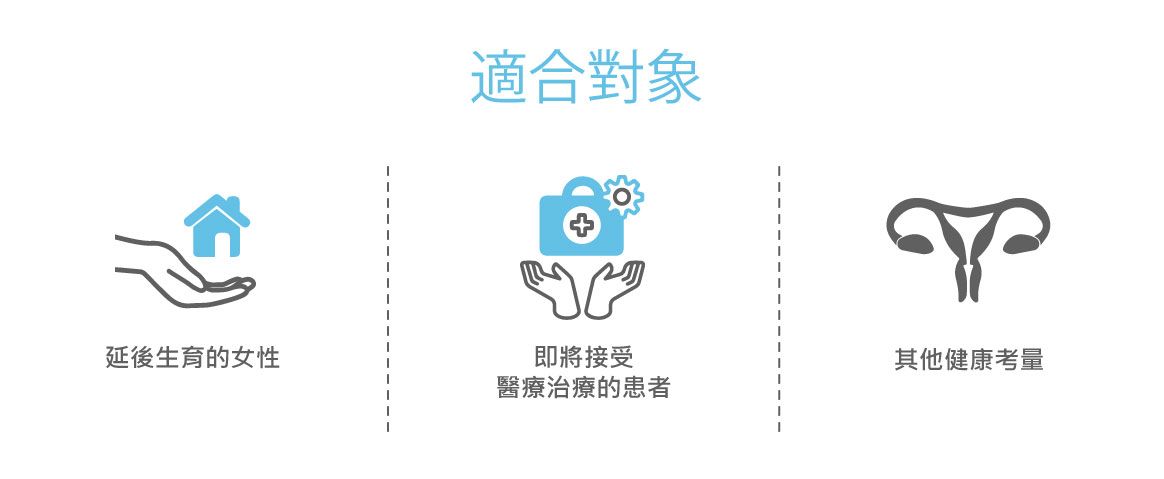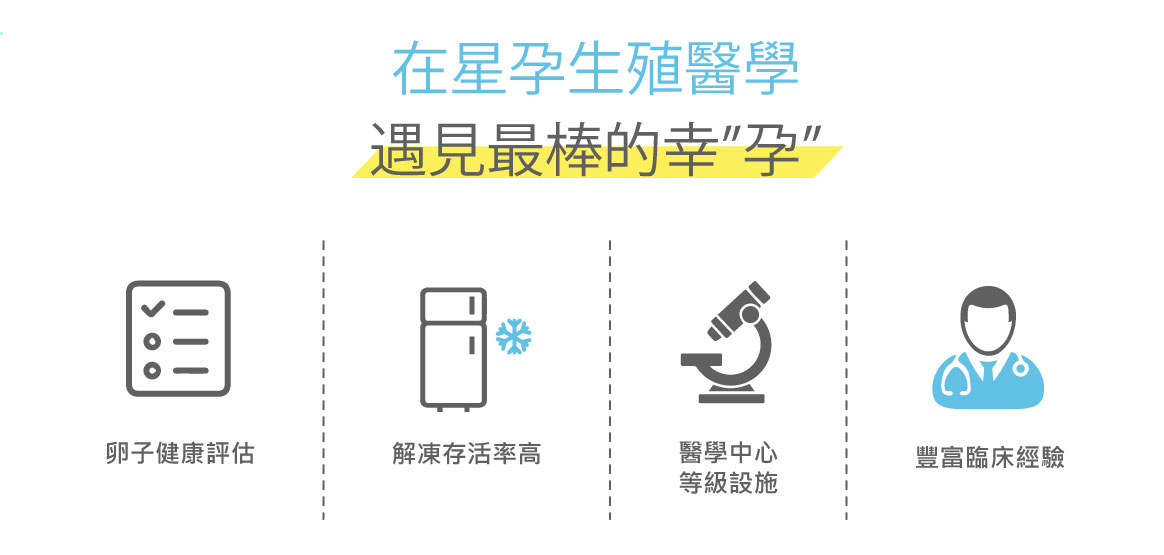冷凍卵子
隨著現代醫學技術的進步,凍卵(卵子冷凍技術)為許多女性提供了一種延緩生育時間、保留生育能力的重要選擇。這項技術特別適合希望在最佳年齡保存卵子品質,但尚未準備懷孕的女性,或者面臨健康問題可能影響卵巢功能的女性。
凍卵是什麼?
凍卵也就是冷凍卵子(英文:Egg Freezing ),是保存生育力的一種人工生殖技術。醫師從女性的卵巢中取出成熟的卵子後,使用快速冷凍技術(玻璃化冷凍)將卵子迅速降溫至零下196℃的液態氮環境中,能有效避免冰晶的形成,保護卵子的細胞結構和品質。待適當時機到來,後續可解凍卵子進行受精動作。
凍卵適合對象
有許多人可能因為癌症,或是年事已高卻苦無對象而無法在預定的時間內完成生育計劃。為了避免在化療後或是卵巢功能衰退更年期後,無法懷孕的狀況,人們可以選擇用冷凍卵子的方式將生育力保存下來。這種治療如同買保險,於該年齡冷凍的卵子,之後解凍使用時的品質就是冷凍當下的品質。
1.延後生育的女性
許多女性因學業、事業或尚未找到合適伴侶等因素,選擇將生育計劃延後。由於卵子品質會隨年齡增長而下降,凍卵可以幫助保存年輕時期的卵子,提升未來懷孕的機率。
2.即將接受醫療治療的患者
一些疾病(如癌症)的治療可能對卵巢功能造成不可逆的損傷。在治療前凍卵,能保留患者未來生育的可能性。
3.其他健康考量
有些女性可能有早發性卵巢衰竭或家族病史,凍卵可以作為保留生育能力的保險措施。
凍卵的適合年齡? 凍卵幾顆才夠?
35 歲是女性生育期的分水嶺,一旦過了 35 歲,不僅卵子數量減少,卵子品質也會逐步下降,研究數據顯示,小於35歲的卵子所形成胚胎染色體正常比例約為65%-70%,35-37歲降到約50%,大於38歲則是小於40%,所以建議35歲前完成生育,否則建議先將卵子凍住在35歲。
凍卵幾顆才夠,一般會建議至少要凍存10~15顆卵子較能確保較高的受孕機率。
凍卵所需AMH值要多少?
AMH值是卵子庫存量的指標,當AMH值越高代表卵子越充足。
一般AMH值(ng/ml)數值狀況如下:
AMH2~5,屬於健康範圍。
AMH<2,代表卵巢機能開始下降卵泡庫存量低。
AMH<1,AMH數值小於1以下,則代表卵巢早衰。
AMH>5,為多囊性卵巢
(延伸閱讀:AMH是什麼?)

凍卵流程
1.初步評估
女性首先需接受專業醫師的諮詢與評估,包括檢查卵巢功能和身體健康狀況。內容為:抽血檢查(卵巢庫存量指標AMH、濾泡刺激激素FSH)、超音波檢查(卵巢濾泡顆數評估)。
2.促進排卵與取出卵子
注射排卵針刺激濾泡生長。由於希望一次存越多卵子越好,因此所使用的排卵針劑量會比較大,使得較多的濾泡一同成長變大。除了連續性的施打之外,在刺激過程中,需要回診照超音波觀察卵子濾泡的大小以及抽血檢查體內荷爾蒙是否足夠讓濾泡成長。醫師會將抽血數值與濾泡影像做比對,判斷是否需要調整排卵針劑的劑量,達到最高效的冷凍卵子療程。
濾泡的大小以及數量足夠時,會施打破卵針並預約取卵手術時間,取卵手術過程約20至30分鐘,屬於微創手術。取卵手術是經由經陰道,透過廣角高解析度定軸陰道超音波探頭導引,用極細的取卵針,將卵巢上成熟的卵子全數從濾泡裡取出來。抽取過程類似抽血,因此沒有傷口,全程睡眠麻醉,沒有疼痛感覺。
3.卵子冷凍保存
卵子取出後,我們的技術員會模擬在人體內的情況,將卵子放在特殊營養液裡處理。處理完畢後,會立即進行玻璃化冷凍,並存放於專業的冷凍設備中(-196℃液態氮恆溫)。
4.未來備孕使用
當女性準備懷孕時,可解凍卵子並進行體外受精(IVF),將胚胎植入子宮等待著床懷孕。
凍卵的優點
1.延長生育選擇的彈性
凍卵讓女性在最佳年齡保存卵子,降低因年齡增加造成的不孕風險。
2.保留生育能力
對於疾病或其他健康因素影響生育能力的女性,凍卵是一種安全有效的保險。
3.心理與生活的自由度
凍卵能讓女性更自由地規劃人生,不再因生育壓力限制個人選擇。
(延伸閱讀:凍卵黃金時期 有凍有機會)
凍卵費用
一次凍卵費用大約10-15萬元,包含身體檢查、排卵針劑、取卵手術流程、冷凍卵子保存費等。凍卵是客製化療程,需經醫師依個人體質差異,來評估用藥需求。
凍卵補助
各縣市補助政策可能隨時間調整,請以各縣市政府相關單位的最新公告為準。
| 縣市 | 補助對象 | 補助內容 | 補助金額 |
| 台北市 | 設籍台北市,40歲(含)以下罹癌女性 | 醫療性凍卵費用及4年保存費 | 最高32,000元(療程20,000元,保存費每年3,000元) |
| 新北市 | 設籍或配偶設籍新北市,40歲以下罹癌女性 | 醫療性凍卵服務費用 | 最高30,000元 |
| 桃園市 | 設籍桃園市,25至40歲(含)女性,或配偶設籍桃園市之外籍人士 | 凍卵療程、管理費用及卵巢功能檢查 | 最高33,000元 |
| 新竹市 | 設籍新竹市滿1年以上,25至40歲(含)女性 | AMH抽血檢驗、凍卵療程、凍卵管理費 | 檢驗:最高1,000元;療程:最高20,000元; 管理費:每年最高2,000元,最多補助5年 |
| 苗栗縣 | 設籍苗栗縣滿6個月,25至40歲(含)女性 | 凍卵療程 | 每案最高20,000元,限額15名 |
| 台中市 | 設籍台中市滿6個月,45歲(含)以下罹癌患者 | 凍卵療程 | 每案補助50,000元,限終身1次 |
| 雲林縣 | 設籍雲林縣滿6個月,25至40歲(含)未婚女性 | 凍卵療程 | 每人補助1次,最高30,000元 |
| 嘉義市 | 設籍嘉義市,女性18至45歲,男性18至49歲罹癌患者 | 凍卵或凍精療程 | 凍卵:最高35,000元; 凍精:最高8,000元,終身各補助1次 |
| 台南市 | 設籍台南市滿6個月,40歲以下罹癌女性 | 醫療性凍卵療程 | 每人補助20,000元,至經費用罄為止 |
常見問題
凍卵是一項改變傳統生育觀念的技術,讓女性在生活與生育之間取得更多平衡。然而,每位女性的身體條件和需求不同,選擇凍卵前應充分了解流程與風險,並與專業醫師討論,尋求最適合自己的生育方案。
1:冷凍的卵子可以保存多久?凍久是否會影響成功率?
理論上可以保存無限期,國健署制定最高保存期限10年,卵子品質不會因冷凍時間而改變,星孕解凍存活率可達90%,受精成功率可達80%。
2:凍卵是否能保證未來懷孕成功?
凍卵不能保證未來一定100%能成功懷孕(需配合著床條件),懷孕率與年齡密切相關仍建議儘早安排生育計劃。
3:凍卵和凍胚有什麼不同?
凍卵是將未受精的卵子冷凍保存,用於未來的人工受精;而凍胚是將已受精的胚胎冷凍,未來可直接用於胚胎植入。
凍卵適合尚未婚女性;凍胚則適合已婚但還不想生育的女性。
4:凍卵每天都要打針嗎?打針會不會很痛?
凍卵的療程中需要每天注射排卵誘導藥物,通常持續 8-10天左右。每個人的痛覺感受不同,大多數患者僅覺得輕微刺痛。
5:冷凍卵子之後解凍,是否會影響卵子的品質與寶寶的健康?
研究顯示,冷凍卵子解凍後的受精率、囊胚率與新鮮卵子相當。現代凍卵技術採用「玻璃化冷凍」方法,可以迅速將卵子冷凍,避免冰晶形成對細胞結構的破壞,最大程度保留卵子的完整性與活性。此外,通過凍卵出生的寶寶與自然懷孕的寶寶在健康和發展上並無顯著差異,但成功率仍受到年齡和卵子品質影響,建議在合適年齡進行凍卵,以獲得更好的結果。
為何選擇星孕生殖醫學中心來凍卵?
星孕生殖醫學中心由鍾繼賢醫師領航,以其專業的生殖技術與貼心的服務,為患者提供全方位的不孕症治療及凍卵服務,讓每位女性在追求生育夢想的過程中感到安心,在星孕遇見最棒的幸”孕”。

專業醫療團隊
星孕生殖醫學中心結合先進的生殖醫學技術,專注於不孕症、人工受孕和試管嬰兒等領域。其專業團隊致力於根據患者的身體狀況設計個人化療程,幫助實現生育計畫。
尖端醫療設備
診所配備先進的實驗室與醫療儀器,包括10000級無菌環境、高解析度超音波及多功能培養箱等,確保胚胎與卵子的培養過程達到最佳條件,進一步提高懷孕率。
一站式服務與便捷性
星孕結合醫學中心的專業水平與社區診所的便利性,患者可以在舒適的環境中完成整套療程,包括術前檢查、取卵手術和術後恢復,無需頻繁往返多個機構,節省時間與精力。
高成功率與個性化照護
星孕以專業的胚胎培養技術和精確的植入操作,大幅提升試管嬰兒及凍卵的成功率。根據患者的卵巢功能和健康狀態,量身打造療程計畫,確保療程對生活影響最小化。
(延伸閱讀:凍卵大解密,14天就能完成整個凍卵流程?! )


